Introduction
Room dividers have long been a practical solution for creating boundaries in open-concept spaces, but they’re more than just functional barriers. When styled thoughtfully, room dividers can transform a room, adding character, storage, and even aesthetic value. Whether you’re working with a studio apartment, an expansive loft, or a shared room, dividers offer endless possibilities to enhance both the flow and design of your space.
I first discovered the power of room dividers while living in a tiny city apartment. With limited square footage and no walls to separate my living, dining, and sleeping areas, it felt chaotic and unorganized. Enter a folding screen! Not only did it create a sense of privacy, but I also realized I could style it to double as a decor piece. Later, I upgraded to a bookshelf-style divider, which provided both storage and a unique way to display books and decor. It was a game-changer, proving that room dividers can be as stylish as they are functional.
In this guide, we’ll explore how to style room dividers to maximize their functionality without sacrificing style. From shelving units to curtains, folding screens to custom installations, we’ll dive into the creative ways you can use dividers to redefine your space.
The Perfect Design for You
Styling room dividers for added functionality is ideal for anyone who wants to create distinct zones within their home while making the most of their space. It’s particularly useful in open-plan layouts, small apartments, or multipurpose rooms where you need to separate areas for privacy or efficiency.
Imagine a studio apartment where a sleek shelving unit divides the bedroom and living area, doubling as a stylish storage solution. Or picture an airy loft with a decorative folding screen that defines a workspace without blocking natural light. With the right styling, dividers can enhance the look and feel of your home, creating boundaries while maintaining a cohesive design.
Whether your style is modern, bohemian, industrial, or traditional, there’s a room divider solution to suit your needs and aesthetic.
Picture Gallery
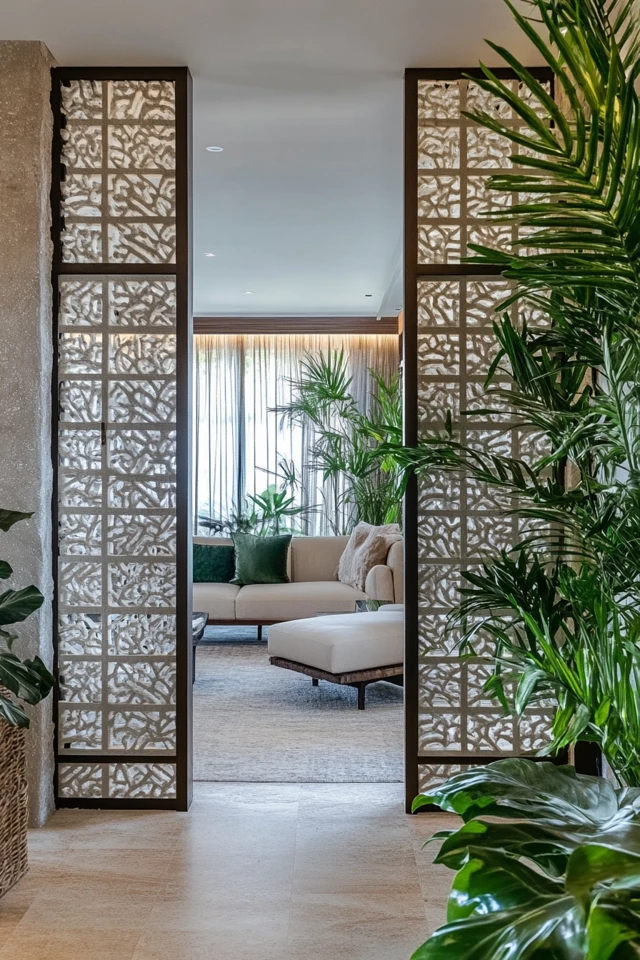

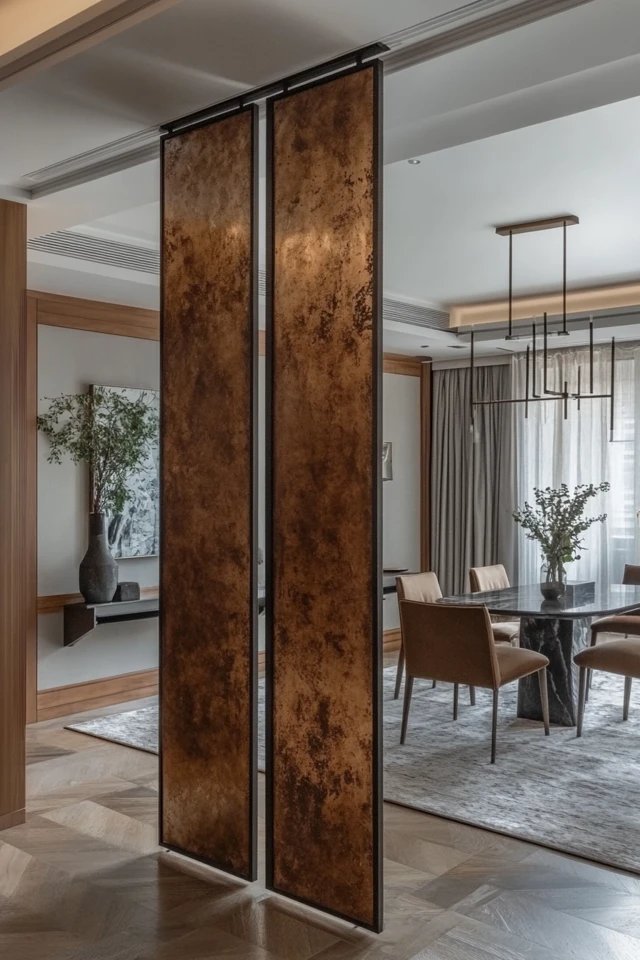
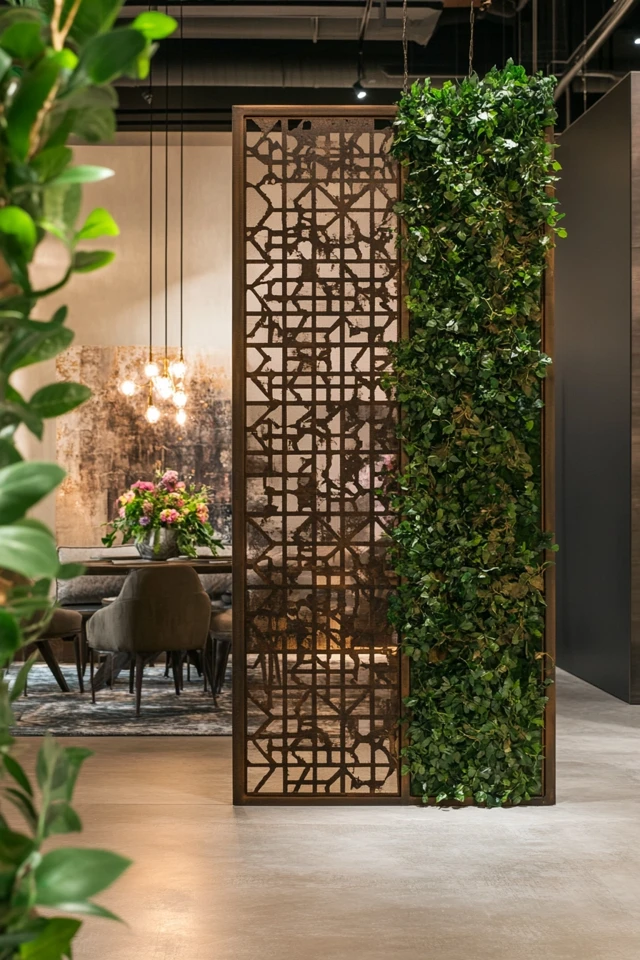
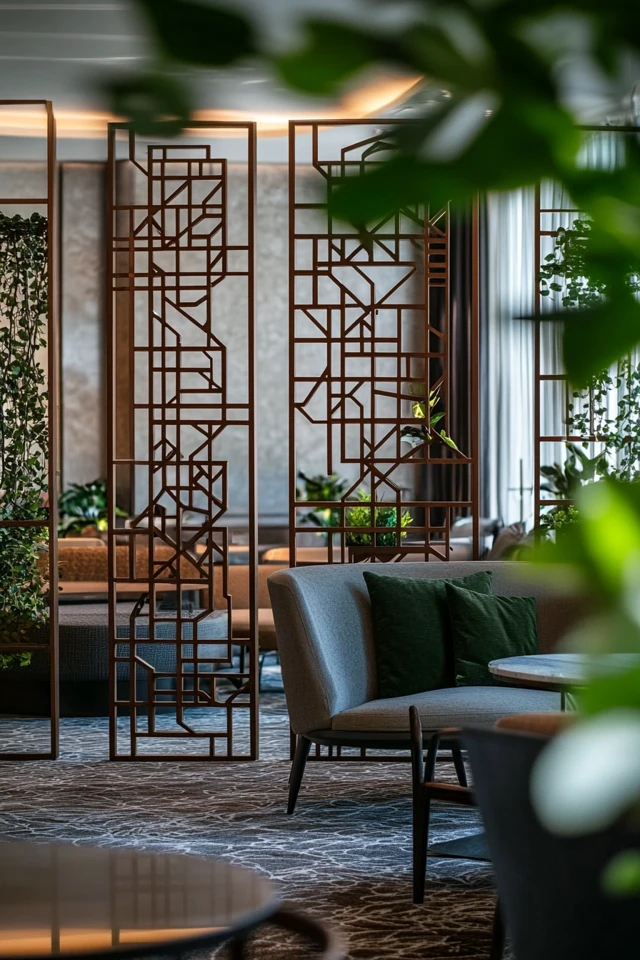
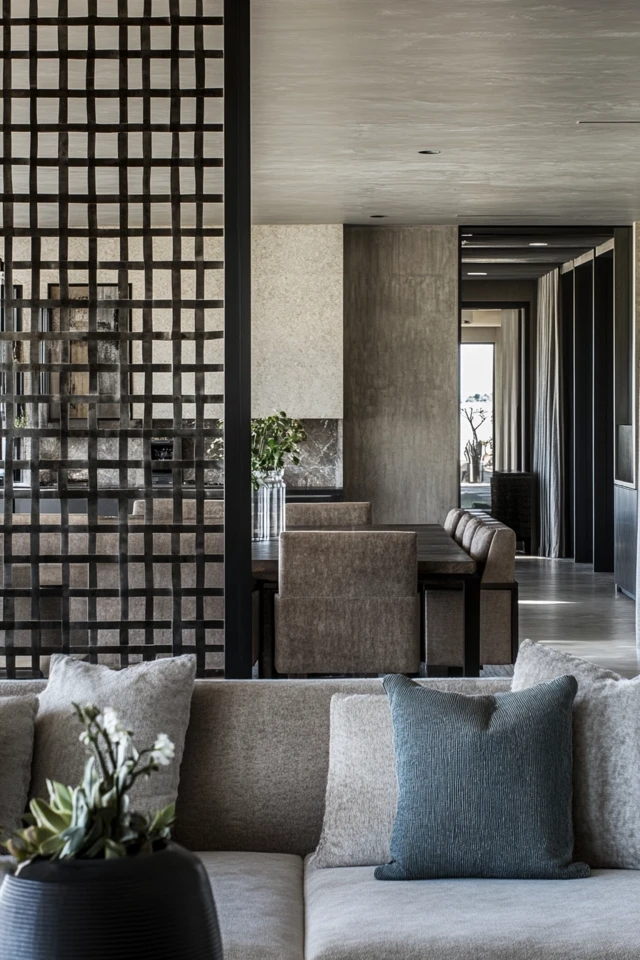
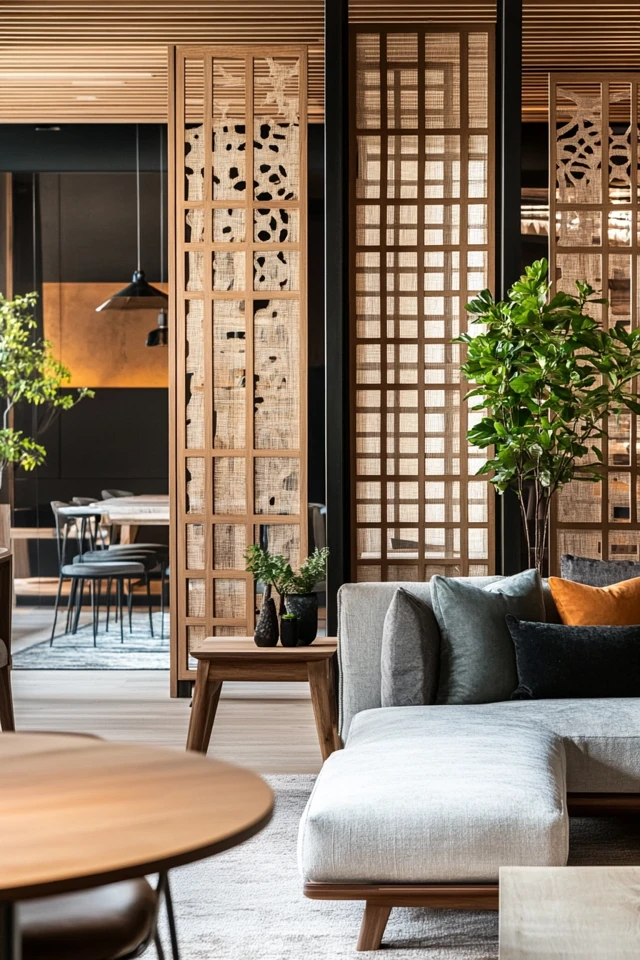
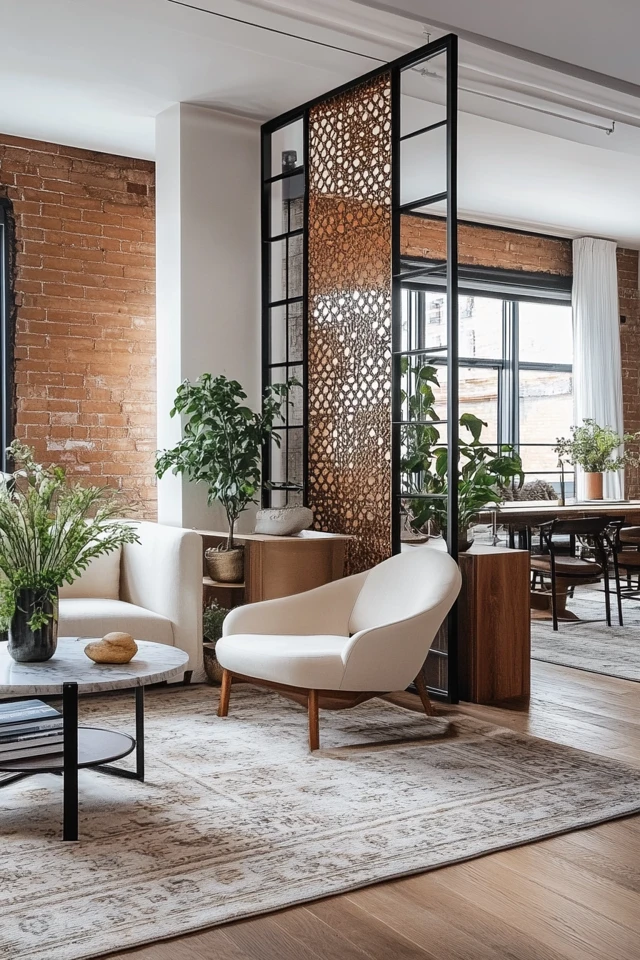
Why These Key Elements Work So Well Together
Room dividers work beautifully when styled with intention, combining functionality and aesthetics in a way that enhances your space. Here’s why these elements work so well:
- Space Optimization: Dividers help you make the most of your square footage, creating designated areas without the need for permanent walls.
- Dual Functionality: Many dividers double as storage, display units, or even vertical gardens, adding practicality to your space.
- Aesthetic Appeal: Stylish dividers can serve as statement pieces, adding texture, color, or pattern to your design.
- Flexibility: Unlike permanent walls, dividers can be moved, rearranged, or swapped out, giving you the flexibility to adapt your space as needed.
- Light and Airflow: Depending on the design, dividers can provide separation without completely blocking light or airflow, keeping the room feeling open and airy.
Design research highlights the importance of multifunctional furniture and flexible layouts, particularly in smaller homes. Room dividers exemplify this principle by combining form and function in one versatile piece.
How to Style Room Dividers for Added Functionality: Step-by-Step
1. Choose the Right Type of Divider
- Select a divider that suits your space and needs:
- Bookshelf Dividers: Ideal for storage and display, these open shelving units create separation while keeping the room connected.
- Folding Screens: Portable and decorative, screens are perfect for temporary divisions or creating privacy in shared spaces.
- Curtains: Lightweight and flexible, curtains are a cost-effective way to divide a room while maintaining softness and flow.
- Slatted or Lattice Dividers: Provide separation without blocking light, perfect for maintaining an open, airy feel.
- Custom Built-Ins: For a more permanent solution, consider custom cabinetry or sliding panels that serve as both dividers and functional furniture.
2. Define Your Zones
- Decide what areas you want to separate and how you’ll use them:
- Living and Dining: Use a low shelving unit or a console table to create a subtle boundary between these zones.
- Bedroom and Living Area: Opt for a tall, opaque divider or a curtain for privacy in studio apartments.
- Workspaces: A folding screen or bookshelf can carve out a home office nook in a shared space.
- Play Areas: Use a colorful, durable divider to create a designated play area for kids in a multipurpose room.
3. Add Storage and Display
- Maximize functionality by choosing dividers that double as storage:
- Use bookshelves to organize books, decor, or storage baskets.
- Incorporate cabinets or drawers for hidden storage.
- Add hooks or racks to the divider for hanging items like coats, hats, or bags.
4. Incorporate Greenery
- Use dividers as a framework for plants to bring life and freshness into your space:
- Hang small planters from slatted dividers or lattice screens.
- Use a bookshelf divider to display potted plants, creating a vertical garden effect.
- Place tall plants, like bamboo or fiddle-leaf figs, near the divider for natural separation.
5. Play with Height and Scale
- Choose a divider height that fits the room’s proportions and purpose:
- Low dividers are great for subtle separation in open-plan spaces.
- Taller dividers provide more privacy and definition, ideal for bedrooms or workspaces.
- Oversized screens or custom-built dividers can create a bold focal point in larger rooms.
6. Use Texture and Pattern
- Add visual interest with dividers that feature texture or pattern:
- Choose a folding screen with intricate carvings or woven details.
- Use fabric or wallpaper-covered panels for a soft, decorative touch.
- Select dividers with slatted wood or metal designs for an industrial or modern aesthetic.
7. Layer Lighting
- Incorporate lighting into or around your divider to enhance functionality:
- Add LED strips to shelving units for a soft, ambient glow.
- Place floor lamps or sconces near the divider to brighten the space.
- Use string lights for a cozy, whimsical touch on fabric or lattice dividers.
8. Ensure Stability and Safety
- Secure your divider to prevent tipping or shifting:
- Anchor bookshelf dividers to the wall if they’re tall or heavily loaded.
- Use sturdy bases for freestanding screens or panels.
- Opt for weighted curtains or tension rods to keep fabric dividers in place.
9. Customize with Decor
- Style the divider to match your room’s aesthetic:
- Add framed photos, sculptures, or vases to shelving units.
- Drape a decorative throw or fabric over folding screens for added softness.
- Paint or stain wooden dividers to coordinate with your color scheme.
10. Reassess and Rearrange
- Periodically reevaluate your layout to ensure it meets your needs:
- Move portable dividers to create new zones or refresh the space.
- Swap out decor or add new elements to keep the design feeling fresh.
FAQ
1. What is the most functional type of room divider?
Bookshelf dividers are among the most functional because they provide storage, display space, and separation in one. Folding screens and curtains are also versatile for temporary or flexible layouts.
2. How can I make a room divider look stylish?
Incorporate decor, such as plants, artwork, or lighting, to enhance the divider’s visual appeal. Choose materials and designs that complement your room’s overall style.
3. Can I use room dividers in small spaces?
Absolutely! Low-profile dividers or open shelving units work well in small spaces, creating separation without making the room feel cramped.
4. How do I use dividers without blocking light?
Opt for slatted, lattice, or open shelving dividers that allow light to pass through while still defining zones.
5. Are room dividers renter-friendly?
Yes! Folding screens, curtains with tension rods, and freestanding dividers are great renter-friendly options that don’t require permanent installation.
Variations
- Modern Minimalism: Use sleek, monochromatic dividers with clean lines, such as metal-framed panels or slatted wood screens.
- Rustic Charm: Opt for wooden dividers with natural finishes, like reclaimed barn wood or woven rattan panels.
- Bohemian Flair: Incorporate folding screens with intricate patterns, colorful curtains, or dividers adorned with macramé or fringe.
- Industrial Edge: Choose dividers made from metal, glass, or exposed piping for a bold, urban look.
- Classic Elegance: Use ornate, carved wood screens or fabric-covered panels in soft, neutral tones for a timeless aesthetic.
How to Showcase It
- Living Rooms: Use a bookshelf divider to create a cozy seating area or define a reading nook.
- Bedrooms: Place a folding screen or curtain to separate the sleeping area in a studio apartment.
- Home Offices: Use a slatted divider or low shelving unit to create a functional workspace within a shared room.
- Dining Areas: Define the dining zone in an open-concept kitchen with a decorative or low-profile divider.
- Kids’ Playrooms: Use colorful, durable dividers to create designated play and storage areas.
Occasions to Feature It
- Everyday Functionality: Divide spaces for better organization and usability in your daily life.
- Entertaining Guests: Use dividers to create intimate seating areas or separate activity zones during gatherings.
- Work-from-Home Setups: Carve out a focused workspace in a shared room with a stylish divider.
- Seasonal Decor: Add festive touches to your divider, like garlands or seasonal decor, for holidays or special occasions.
- Temporary Changes: Rearrange or introduce portable dividers to accommodate changing needs, like hosting overnight guests.
Conclusion
Room dividers are more than just functional barriers—they’re versatile design tools that can redefine your space while adding style and practicality. Whether you’re working with a small studio or a spacious open-plan layout, dividers allow you to create distinct zones, enhance privacy, and add personality to your home.
The key is choosing the right type of divider for your needs and styling it thoughtfully. By incorporating storage, decor, lighting, and greenery, you can transform a simple divider into a multifunctional centerpiece that elevates your entire space.
So embrace the potential of room dividers and experiment with these creative ideas. With the perfect balance of functionality and aesthetics, you’ll create a home that’s both beautiful and beautifully organized.


